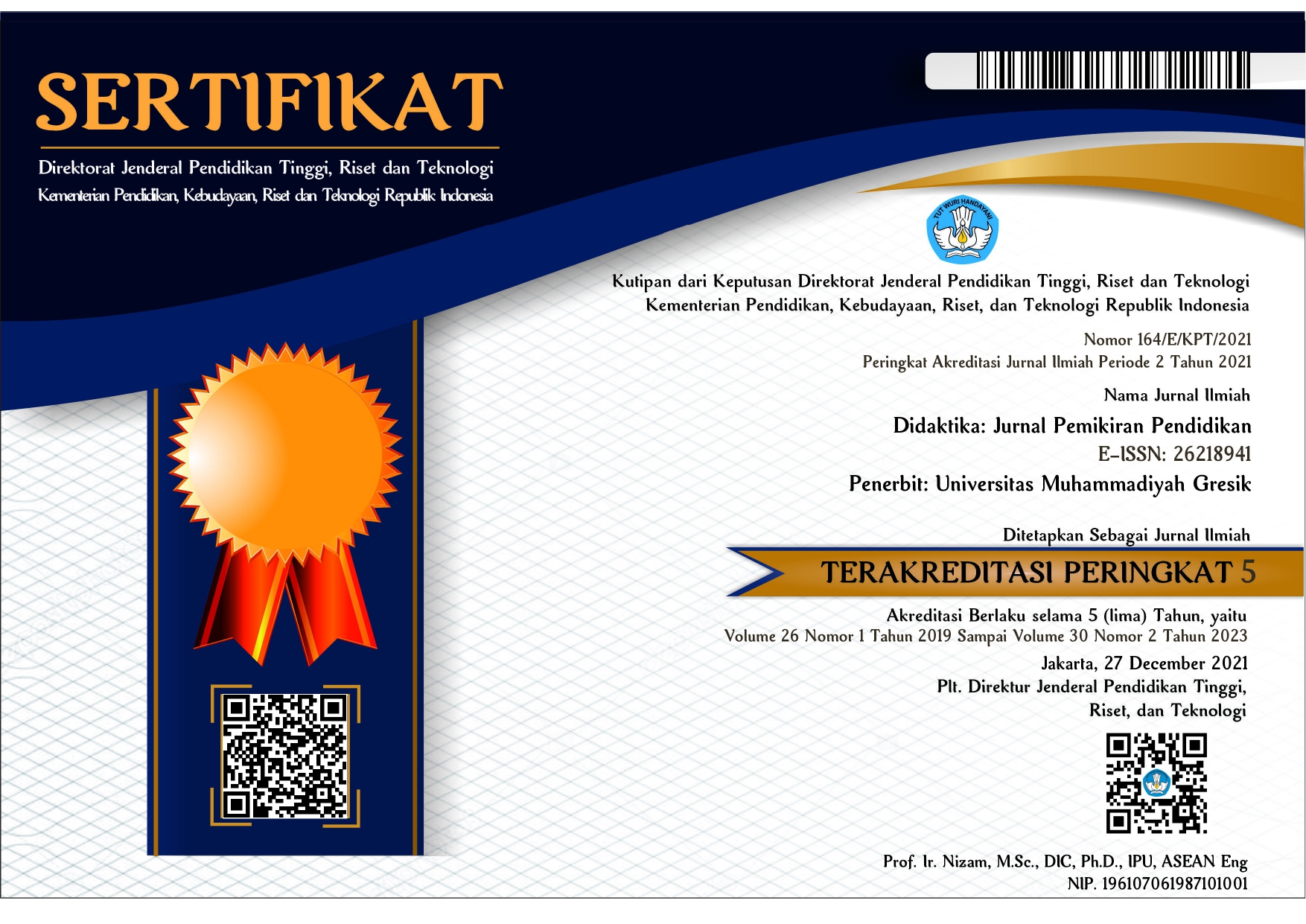Analysis of Problem-Solving Abilities Based on Student Proficiency Levels in D Phase
DOI:
https://doi.org/10.30587/didaktika.v30i2.7759Keywords:
Problem-Solving, Student Profiency Levels, Phase DAbstract
This study investigates the problem-solving abilities of seventh-grade students at SMP Muhammadiyah 1 Gresik in the context of flat-sided spatial figures. Employing a qualitative descriptive approach, the study involved three subjects representing varying levels of problem-solving abilities: excellent, moderate, and low. Data collection was conducted through tests, observations, and in-depth interviews. The findings revealed a range of problem-solving abilities among the three subjects. The student with excellent problem-solving skills demonstrated the ability to comprehend the problem, employ clear and rational strategies, construct accurate mathematical models, and thoroughly check their answers. The subject with moderate problem-solving skills exhibited an understanding of the problem and utilized rational strategies; however, they faced challenges in creating accurate models and drawing conclusions. The subject with low problem-solving skills encountered difficulties in comprehending the problem, selecting appropriate strategies, and correctly solving the problem. The study's conclusions emphasize the need for specialized attention and guidance for students with low problem-solving abilities to foster their effective problem-solving skills. Conversely, students with high problem-solving abilities can be provided with more complex challenges to optimize their capabilities. This research provides a foundation for teachers to tailor their support to students' individual problem-solving abilities in mathematics.
References
Anggraeni, R., & Kadarisma, G. (2020). Analisis Kemampuan Pemecahan Masalah Matematik Siswa Smp Kelas VII Pada Materi Himpunan. Jurnal Cendekia : Jurnal Pendidikan Matematika, 4(2), Article 2. https://doi.org/10.31004/cendekia.v4i2.334
Corte, E., Greer, B., & Verschaffel, L. (1996). Mathematics teaching and learning. https://www.semanticscholar.org/paper/Mathematics-teaching-and-learning.-Corte-Greer/b69cc5fe16e8d4155115febbbb12abc936ad4cc9
Ennis, R. H. (1993). Critical thinking assessment. Theory Into Practice, 32(3), 179–186. https://doi.org/10.1080/00405849309543594
Freudenthal, H. (2005). Revisiting Mathematics Education: China Lectures. Springer Science & Business Media.
Imroatun, S. (2014). Strategi Pemecahan Masalah Matematika Siswa Kelas VII SMP Kristen 2 Salatiga Ditinjau Dari Langkah Polya.
Khoerunnisa, G. M., & Imami, A. I. (2020). Analisis Kemampuan Pemecahan Masalah Matematis Siswa SMP Pada Materi SPLDV. Prosiding Sesiomadika, 2(1b), Article 1b. https://journal.unsika.ac.id/index.php/sesiomadika/article/view/2750
National Council of Teachers of Mathematics. (1999). Principles and Standards for School Mathematics. https://www.nctm.org/Standards-and-Positions/Principles-and-Standards/
OECD. (2019). PISA 2018 Results (Volume I): What Students Know and Can Do. OECD. https://doi.org/10.1787/5f07c754-en
Polya, G. (2004). How to Solve It: A New Aspect of Mathematical Method. Princeton University Press.
Rahmawati, A., & Warmi, A. (2022). Analisis Kemampuan Pemecahan Masalah Matematis Siswa SMP Pada Materi Teorema Pythagoras. Jurnal Cendekia : Jurnal Pendidikan Matematika, 6(1), 365–374. https://doi.org/10.31004/cendekia.v6i1.1012
Rio, M., & Pujiastuti, H. (2020). Analisis Kemampuan Pemecahan Masalah Matematik Siswa Smp Pada Materi Bilangan Bulat. AKSIOMA : Jurnal Matematika dan Pendidikan Matematika, 11(1), Article 1. https://doi.org/10.26877/aks.v11i1.6105
Sari, Y. P., Amilda, A., & Syutaridho, S. (2017). IDENTIFIKASI KEMAMPUAN KOGNITIF SISWA DALAM MENYELESAIKAN SOAL-SOAL MATERI BANGUN RUANG SISI DATAR. Jurnal Pendidikan Matematika RAFA, 3(2), 146–164. https://doi.org/10.19109/jpmrafa.v3i2.1738
Downloads
Published
How to Cite
Issue
Section
License
License and Copyright Agreement
In submitting the manuscript to the journal, the authors certify that:
- They are authorized by their co-authors to enter into these arrangements.
- The work described has not been formally published before, except in the form of an abstract or as part of a published lecture, review, thesis, or overlay journal.
- That it is not under consideration for publication elsewhere,
- That its publication has been approved by all the author(s) and by the responsible authorities – tacitly or explicitly – of the institutes where the work has been carried out.
- They secure the right to reproduce any material that has already been published or copyrighted elsewhere.
- They agree to the following license and copyright agreement.
Copyright
Authors who publish with DIDAKTIKA: Jurnal Pemikiran Pendidikan agree to the following terms:
- Authors retain copyright and grant the journal right of first publication with the work simultaneously licensed under a Creative Commons Attribution License (CC BY-SA 4.0) that allows others to share the work with an acknowledgment of the work's authorship and initial publication in this journal.
- Authors are able to enter into separate, additional contractual arrangements for the non-exclusive distribution of the journal's published version of the work (e.g., post it to an institutional repository or publish it in a book), with an acknowledgment of its initial publication in this journal.
- Authors are permitted and encouraged to post their work online (e.g., in institutional repositories or on their website) prior to and during the submission process, as it can lead to productive exchanges, as well as earlier and greater citation of published work.
Licensing for Data Publication
Open Data and Software Publishing and Sharing
The journal strives to maximize the replicability of the research published in it. Authors are thus required to share all data, code or protocols underlying the research reported in their articles. Exceptions are permitted but have to be justified in a written public statement accompanying the article.
Datasets and software should be deposited and permanently archived inappropriate, trusted, general, or domain-specific repositories (please consult http://service.re3data.org and/or software repositories such as GitHub, GitLab, Bioinformatics.org, or equivalent). The associated persistent identifiers (e.g. DOI, or others) of the dataset(s) must be included in the data or software resources section of the article. Reference(s) to datasets and software should also be included in the reference list of the article with DOIs (where available). Where no domain-specific data repository exists, authors should deposit their datasets in a general repository such as ZENODO, Dryad, Dataverse, or others.
Small data may also be published as data files or packages supplementary to a research article, however, the authors should prefer in all cases a deposition in data repositories.











